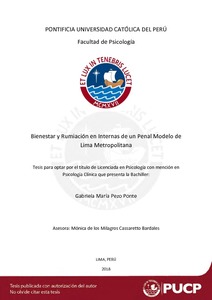| dc.contributor.advisor | Cassaretto Bardales, Mónica de los Milagros | es_ES |
| dc.contributor.author | Pezo Ponte, Gabriela María | es_ES |
| dc.date.accessioned | 2018-02-22T17:24:22Z | es_ES |
| dc.date.available | 2018-02-22T17:24:22Z | es_ES |
| dc.date.created | 2018 | es_ES |
| dc.date.issued | 2018-02-22 | es_ES |
| dc.identifier.uri | http://hdl.handle.net/20.500.12404/10183 | |
| dc.description.abstract | La presente investigación tuvo como objetivo identificar la relación entre el Bienestar y la Rumiación,
en un grupo de internas de un penal modelo de Lima Metropolitana; buscando hallar las diferencias
existentes, referentes a dichos constructos, y respecto a las características sociodemográficas y
penitenciarias de las internas. Para ello, se realizó una investigación cuantitativa, donde participaron
84 internas de entre 18 y 57 años de edad (M=35.68, DE=11.32); evaluadas utilizando las Escalas de
Bienestar: Flourishing y Spane (Diener et al., 2009), y la Escala de Respuestas Rumiativas (Nolen-
Hoeksema, Morrow y Fredrickson, 1990). Los resultados muestran que la variable Afectividad
Negativa fue la única en presentar una relación directa tanto con la variable rumiación general, como
con reproches y reflexión de manera específica (r=.52**, r=.53** y r=.51**, respectivamente).
Además, se obtuvo que las internas presentaban mayores afectos positivos, frente a los negativos.
Asimismo, se encontró que el afecto positivo era mayor en quienes reportaban no tener hijos, recibir
visita, asistir a terapia psicológica, así como a todas las actividades continuas del área de psicología.
También, se obtuvo que el nivel de florecimiento era mayor en quienes asistían a terapia individual. La
rumiación, obtuvo relaciones significativas, pequeñas e inversas con la edad de las participantes y el
tiempo de reclusión (r=-.24* y r=-.25*, respectivamente). Además, la dimensión reproches obtuvo
una relación significativa, pequeña e inversa con el tiempo de reclusión (r=-.24*). Por otro lado, la
variable reflexión obtuvo una relación pequeña, significativa e inversa con la edad de las participantes
(r=-.25*). | es_ES |
| dc.description.abstract | The present research aims to identify the relationship between Wellbeing and Ruminative Thoughts in
a group of women inmates of a model penitentiary in Metropolitan Lima. Likewise, it has been sought
to find a possible difference in well-being and rumination according sociodemographic and
penitentiary characteristics. For this, a quantitative investigation was carried out, counting with the
participation of 84 women inmates, aged between 18 - 57 years (M=35.68, DE=11.32), evaluated
using the Flourishing and Spane Scales (Diener et al., 2009), and the Ruminative Response Scale
(Nolen-Hoeksema, Morrow y Fredrickson, 1990). Results show that negative affection was the only
one which presents a direct relation with rumination, brooding and reflection (r=.52**, r=.53** y
r=.51**, respectively). Also, it has been found that the inmates showed more positive affection than
negative affection. Likewise, it has been found that the positive affection was higher in the inmates
who report not having children, receiving visits, attending psychological therapy, as well as all the
ongoing activities of psychology. Also, the level of flourishing was higher in the ones who attend to
psychological therapy. Rumination showed significant, little and reverse relations with age of
participants and reclusion time (r=-.24* y r=-.25*, respectively). Also, brooding had a significant,
little and reverse relation with reclusion time (r=-.24*). On the other hand, reflection had a significant,
little and reverse relation with age of participants (r=-.25*). | es_ES |
| dc.language.iso | spa | es_ES |
| dc.publisher | Pontificia Universidad Católica del Perú | es_ES |
| dc.rights | info:eu-repo/semantics/openAccess | es_ES |
| dc.rights.uri | http://creativecommons.org/licenses/by-nc-sa/2.5/pe/ | * |
| dc.subject | Bienestar | es_ES |
| dc.subject | Depresión mental | es_ES |
| dc.subject | Prisiones para mujeres | es_ES |
| dc.title | Bienestar y rumiación en internas de un penal modelo de Lima Metropolitana | es_ES |
| dc.type | info:eu-repo/semantics/bachelorThesis | es_ES |
| thesis.degree.name | Licenciado en Psicología con mención en Psicología Clínica | es_ES |
| thesis.degree.level | Título Profesional | es_ES |
| thesis.degree.grantor | Pontificia Universidad Católica del Perú. Facultad de Psicología | es_ES |
| thesis.degree.discipline | Psicología con mención en Psicología Clínica | es_ES |
| renati.advisor.dni | 09491245 | |
| renati.advisor.orcid | https://orcid.org/0000-0002-4880-6092 | es_ES |
| renati.discipline | 313026 | es_ES |
| renati.level | https://purl.org/pe-repo/renati/level#tituloProfesional | es_ES |
| renati.type | http://purl.org/pe-repo/renati/type#tesis | es_ES |
| dc.publisher.country | PE | es_ES |
| dc.subject.ocde | https://purl.org/pe-repo/ocde/ford#5.01.00 | es_ES |






